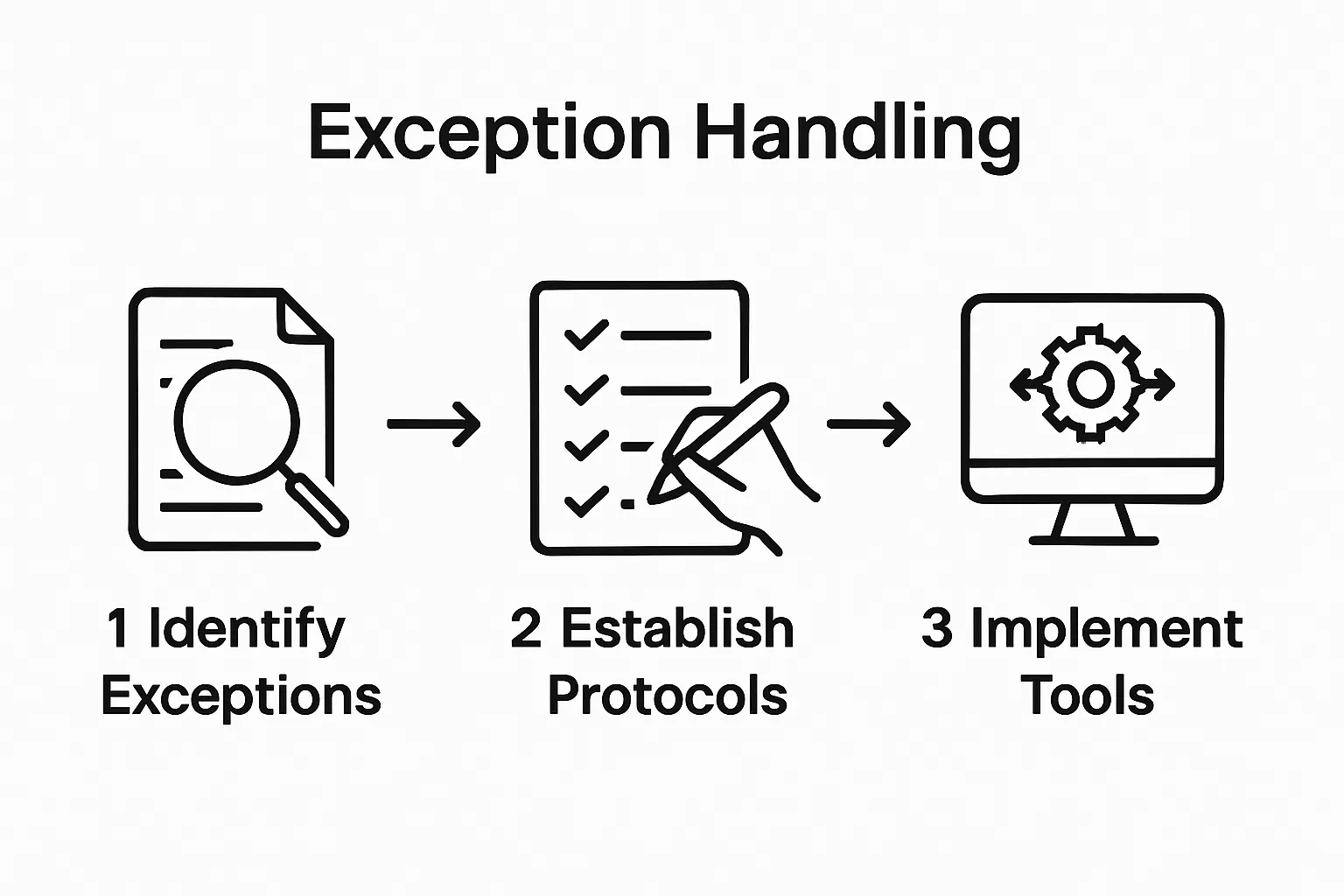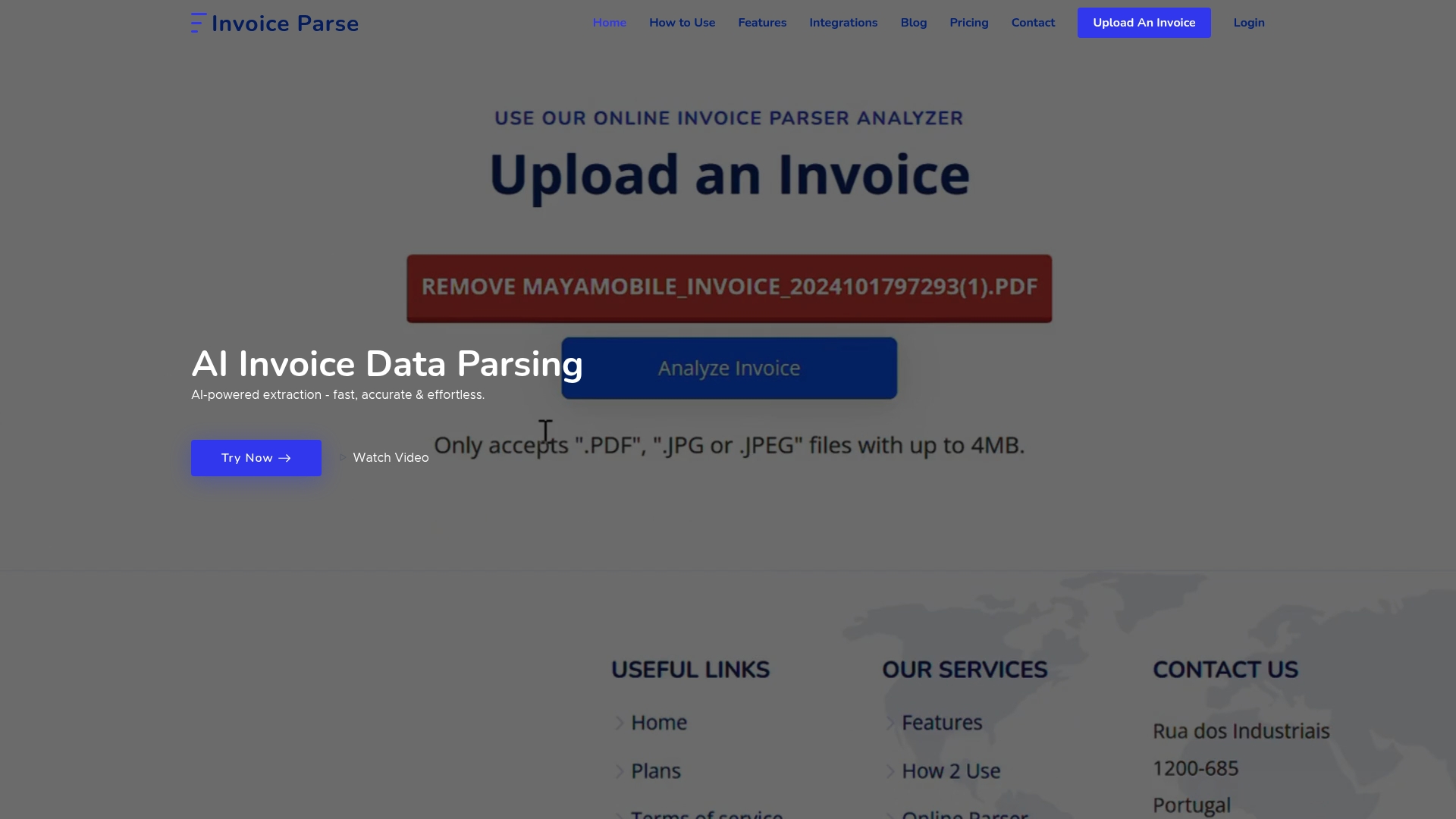Invoice errors can quietly drain profits and disrupt cash flow in any finance department. Yet most teams overlook that these exception scenarios account for up to 60 percent of processing delays when not managed with the right tools. It might sound like extra work to set up exception handling systems, but companies that build these smart frameworks actually cut troubleshooting time dramatically and see smoother operations than ever before.

How to Handle Exceptions for Efficient Invoice Processing
Table of Contents
- Step 1: Identify Common Exception Scenarios
- Step 2: Establish Clear Exception Handling Protocols
- Step 3: Implement Exception Handling Tools and Software
- Step 4: Train Your Team on Exception Management
- Step 5: Monitor and Review Exception Handling Performance
Quick Summary
| Key Point | Explanation |
|---|---|
| 1. Develop an exception tracking framework | Create a structured system to identify and document invoice processing issues for better management and resolution. |
| 2. Implement clear exception handling protocols | Establish detailed response matrices and roles to ensure efficient resolution of invoice discrepancies. |
| 3. Use automated exception handling tools | Transition to software solutions that provide real-time tracking and reduce processing times significantly. |
| 4. Train your team continuously | Provide ongoing training for staff to improve their skills in managing exceptions and using new technologies. |
| 5. Monitor and review performance regularly | Establish a system for tracking key performance metrics and conducting regular reviews to identify improvement opportunities. |
Step 1: Identify Common Exception Scenarios
Successful invoice processing begins with strategic exception management. By systematically identifying potential problems before they escalate, organizations can prevent costly delays and financial inaccuracies. Research from financial management experts confirms that proactive exception scenario recognition significantly reduces processing bottlenecks.
The first critical action is developing a comprehensive exception tracking framework. This involves carefully examining your current invoice processing workflow and documenting recurring issues that disrupt smooth financial operations. Common exceptions typically include data inconsistencies, pricing discrepancies, vendor information mismatches, and authorization gaps.
Start by conducting a detailed audit of recent invoice processing records. Review historical documentation to pinpoint patterns of repeated problems. Pay close attention to transactions that required manual intervention or caused workflow interruptions. Look for specific indicators such as:
- Invoices with misaligned line item totals
- Duplicate invoice submissions
- Incomplete vendor registration details
- Pricing variations outside predefined tolerance levels
- Invoices lacking required approval signatures
Create a standardized exception categorization system that classifies issues by type, frequency, and potential financial impact. This approach transforms seemingly random disruptions into manageable, predictable scenarios.
Below is a table summarizing common invoice processing exceptions, their causes, and impacts to help streamline identification and tracking.
| Exception Scenario | Likely Cause | Typical Impact |
|---|---|---|
| Misaligned line item totals | Data entry inconsistency | Invoice approval delays |
| Duplicate invoice submissions | Lack of cross-checking or controls | Double payments, manual correction |
| Incomplete vendor registration | Missing or rushed onboarding data | Inability to process payment |
| Pricing variations | Pricing errors or outdated data | Discrepancy investigation needed |
| Missing approval signatures | Workflow step missed | Processing interruption |
 Use internal reporting tools or spreadsheet software to track and analyze these exceptions systematically.
Use internal reporting tools or spreadsheet software to track and analyze these exceptions systematically.
Implement a cross-functional review process where accounting, procurement, and finance teams collaboratively discuss and validate identified exception scenarios. Regular communication helps build a comprehensive understanding of potential workflow disruptions and develops collaborative strategies for mitigation.
Successful completion of this step means having a clear, documented inventory of potential invoice processing exceptions. Your framework should enable quick identification, efficient routing, and streamlined resolution of financial document discrepancies. The goal is transforming exceptions from unexpected obstacles into manageable, predictable workflow components.
Step 2: Establish Clear Exception Handling Protocols
After identifying potential invoice processing exceptions, the next crucial step is developing robust protocols that transform these challenges into manageable workflows. Research from financial management systems emphasizes the importance of structured exception management in preventing operational disruptions.
Begin by creating a comprehensive exception response matrix that outlines specific actions for different types of invoice discrepancies. This strategic document serves as a roadmap for your team, providing clear guidance on handling various scenarios. The matrix should detail the exact steps for resolution, responsible team members, and maximum acceptable resolution timeframes.
Develop a tiered escalation process that defines how exceptions move through your organizational hierarchy. Each exception type should have predefined pathways indicating when and how an issue moves from initial detection to specialized review. For instance, minor data inconsistencies might be resolved by junior accounting staff, while significant pricing discrepancies require senior financial manager intervention.
Establish clear communication channels that enable rapid information exchange during exception handling. This might involve creating dedicated communication tools or specific email protocols that ensure quick notification and collaborative problem solving. Implement a tracking system that provides real time visibility into exception status, allowing team members to monitor progress and understand bottlenecks.
Key components of effective exception handling protocols include:
- Precise definition of exception categories
- Clear responsibility assignments
- Standardized resolution workflows
- Mandatory documentation requirements
- Performance tracking mechanisms
Design your protocols with flexibility in mind. While standardization is crucial, your system should allow for nuanced decision making. Include guidelines that empower team members to make informed judgments while maintaining overall process integrity.
Verification of successful protocol establishment includes having a fully documented system that can be consistently applied across invoice processing scenarios. Your team should demonstrate a shared understanding of exception handling procedures, with measurable improvements in processing speed and accuracy. Regular training and periodic protocol reviews will ensure your exception management remains adaptive and effective.
Step 3: Implement Exception Handling Tools and Software
Transitioning from manual exception tracking to automated solutions represents a critical evolution in invoice processing efficiency. Financial technology research indicates that organizations implementing specialized exception handling tools can reduce processing time by up to 60 percent.
Begin by conducting a comprehensive assessment of your current technological infrastructure. Evaluate existing accounting and enterprise resource planning (ERP) systems to determine their exception handling capabilities. Look for software solutions that offer seamless integration, robust reporting features, and advanced machine learning capabilities to predict and mitigate potential invoice processing disruptions.
Select tools that provide real time exception tracking and automated routing mechanisms.
Modern exception management software should enable intelligent workflow redirection, allowing complex issues to be automatically escalated to appropriate team members based on predefined rules. Prioritize solutions that offer customizable dashboards, enabling visual representation of exception status and trends.
Key technological capabilities to seek in exception handling tools include:
- Advanced optical character recognition (OCR) for accurate data extraction
- Machine learning algorithms for pattern recognition
- Automated validation against predefined business rules
- Comprehensive audit trail and reporting functionalities
- Seamless integration with existing financial systems
Implement a phased rollout strategy when introducing new exception handling software. Begin with a pilot program involving a small, cross functional team that can provide detailed feedback and help refine the implementation approach. This incremental deployment allows for system optimization and minimizes potential operational disruptions.
Configuration is crucial during tool implementation. Work closely with your software vendor to develop custom rules that align with your organization’s specific invoice processing requirements. These rules should reflect the exception categorization framework established in previous steps, ensuring a cohesive and intelligent approach to financial document management.
Successful implementation means having a fully integrated exception handling system that reduces manual intervention, provides comprehensive visibility into processing workflows, and enables data driven decision making. Regular performance monitoring and continuous system refinement will help maintain the effectiveness of your technological solution.
Step 4: Train Your Team on Exception Management
Effective exception management relies on a well prepared and knowledgeable team. Research highlights the critical importance of continuous training in maintaining operational efficiency and reducing processing errors.
Design a comprehensive training program that goes beyond traditional instructional methods. Create an immersive learning experience that combines theoretical knowledge with practical skill development. Start by developing a multi tiered training curriculum that addresses different expertise levels within your organization, from entry level accounting staff to senior financial managers.
Begin with a foundational workshop that introduces the comprehensive exception management framework developed in previous steps. This initial session should provide a holistic understanding of why exception handling matters and how it directly impacts the organization’s financial health. Use real world case studies and interactive scenarios to demonstrate the practical implications of effective exception management.
Develop hands on training modules that simulate actual invoice processing challenges. These practical exercises should leverage the exception handling tools and software implemented in the previous step. Create scenarios that mirror complex real world situations, allowing team members to practice using the new technological solutions in a controlled environment.
Key training program components include:
- Detailed walkthroughs of exception identification processes
- Practical demonstrations of software tool functionalities
- Interactive problem solving workshops
- Scenario based learning experiences
- Performance assessment and feedback mechanisms
Implement a mentorship program that pairs experienced team members with newer staff. This approach facilitates knowledge transfer and provides ongoing support beyond formal training sessions. Encourage senior team members to share insights about nuanced exception handling strategies that are not typically captured in standard documentation.
Establish a continuous learning framework that includes regular refresher courses and update sessions. As exception handling protocols and technologies evolve, your team must stay current. Schedule quarterly review meetings to discuss emerging trends, share lessons learned, and refine existing processes.
Successful team training is verified through measurable improvements in exception handling efficiency. Look for reduced processing times, decreased error rates, and increased team confidence in managing complex invoice exceptions. Create assessment metrics that track individual and team performance, using these insights to continuously improve your training approach.
Step 5: Monitor and Review Exception Handling Performance
Continuous performance monitoring transforms exception handling from a static process into a dynamic, adaptive system. Research demonstrates the critical importance of systematic performance review in maintaining operational excellence.
Establish a comprehensive performance tracking framework that captures detailed metrics across multiple dimensions of invoice exception management. This approach goes beyond simple error tracking, providing a holistic view of your organization’s processing efficiency. Develop a centralized dashboard that consolidates key performance indicators, allowing real time visibility into exception handling effectiveness.
Identify and prioritize critical performance metrics that directly reflect the health of your exception management system. Focus on quantitative measures such as average resolution time, exception frequency, error reduction rates, and financial impact. Complement these numerical insights with qualitative assessments that capture team performance, process adaptability, and overall workflow efficiency.
Implement a robust data collection methodology that ensures accurate and consistent performance measurement. Leverage the exception handling tools and software developed in previous steps to automatically capture and analyze processing data. Configure advanced reporting features that generate detailed insights, enabling your team to identify patterns, trends, and potential improvement areas.
Key performance monitoring elements include:
- Detailed exception resolution time tracking
- Error rate analysis across different invoice categories
- Financial impact assessment of processing exceptions
- Team efficiency and skill development metrics
- Comparative performance benchmarking
Schedule regular review meetings that bring together cross functional teams to analyze performance data. These sessions should be more than routine check ins they are strategic planning opportunities to discuss insights, challenge existing processes, and develop targeted improvement strategies. Encourage open dialogue and collaborative problem solving during these reviews.
Develop a continuous improvement protocol that transforms performance insights into actionable enhancements. When recurring issues or inefficiencies are identified, create specific intervention plans. This might involve refining exception handling protocols, providing additional team training, or upgrading technological tools.
Successful performance monitoring is characterized by demonstrable improvements in invoice processing efficiency. Look for reduced exception resolution times, decreased error rates, and enhanced financial accuracy. The ultimate goal is creating a self optimizing system that continuously adapts and improves based on real world performance data.
Here is a checklist table to help you verify the successful implementation of performance monitoring for invoice exception handling.
| Verification Step | Completion Indicator |
|---|---|
| Performance tracking framework is established | Centralized dashboard in use |
| Key metrics are identified and monitored | Regular metric review meetings held |
| Automated and consistent data collection in place | Exception data captured in real time |
| Regular cross-functional review meetings scheduled | Collaborative analysis performed |
| Continuous improvement protocol is operational | Intervention plans for recurring issues |

Turn Invoice Exceptions Into Seamless Automation With Invoice Parse
Struggling with recurring invoice processing exceptions or manual errors? The article highlights the daily headaches caused by inconsistent data, duplicate entries, and slow exception handling. These issues waste time, drain resources, and create stressful financial uncertainty. At this stage, having a clear exception tracking framework and real-time exception management tools is not just helpful—it is absolutely critical for your business health.

What if you could eliminate manual data entry and catch exceptions before they cause problems? Invoice Parse uses advanced AI to instantly extract accurate and structured data from your invoices, including vendor details, totals, line items, and more. With effortless drag-and-drop uploads and real-time results, your team can immediately address data inconsistencies or missing fields. Integrate easily with Excel, Power BI, or automated workflows, so nothing slips through the cracks. Simplify your process, reduce human error, and give your team more time to focus on growth. Ready to automate invoice exception management and boost accuracy today? Get started at Invoice Parse and experience instant clarity in your finance operations.
Frequently Asked Questions
What are common exception scenarios in invoice processing?
Common exception scenarios include data inconsistencies, pricing discrepancies, vendor information mismatches, and authorization gaps. Identifying these issues early can help prevent costly delays and financial inaccuracies.
How can I establish effective exception handling protocols?
To establish effective protocols, create an exception response matrix outlining specific actions for various discrepancies. Additionally, implement a tiered escalation process to define how exceptions are handled based on severity and complexity.
What tools and software can aid in exception handling for invoices?
Look for tools that offer real-time exception tracking, automated routing, and advanced features like optical character recognition (OCR) and machine learning for pattern recognition. These tools can significantly reduce manual intervention and processing time.
How can team training improve exception management?
Team training enhances exception management by ensuring staff is knowledgeable about the workflows and tools involved. A well-designed training program should include practical exercises, mentorship, and regular updates to keep the team informed about new processes and technologies.
Recommended
- AI Invoice Parse – Invoice Processing Best Practices for Efficient Workflows
- AI Invoice Parse – Top Challenges in Invoice Processing and How to Overcome Them
- AI Invoice Parse – Understanding Invoice Workflow: Key Concepts and Insights
- AI Invoice Parse – How to Prevent Invoice Fraud: Practical Steps for Businesses
